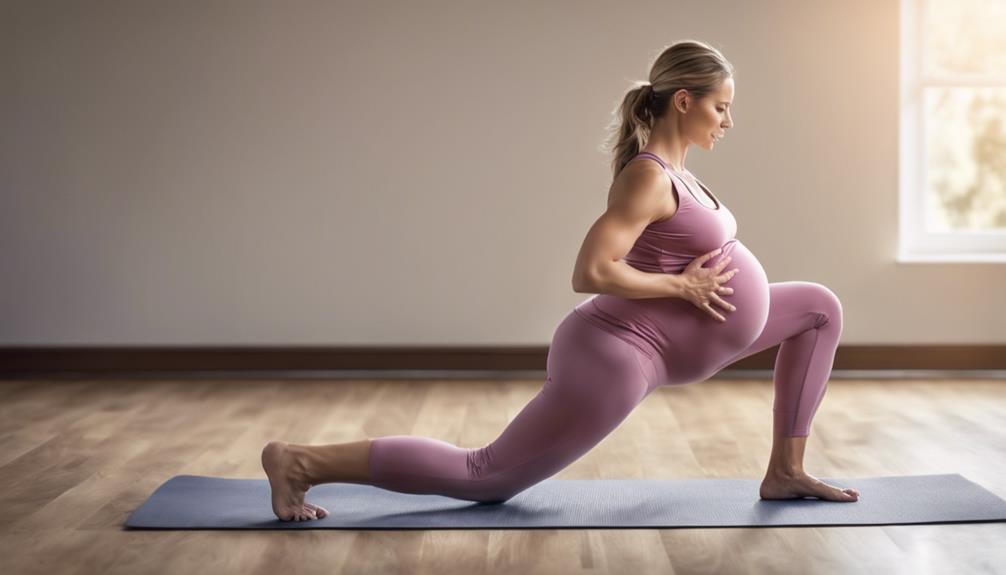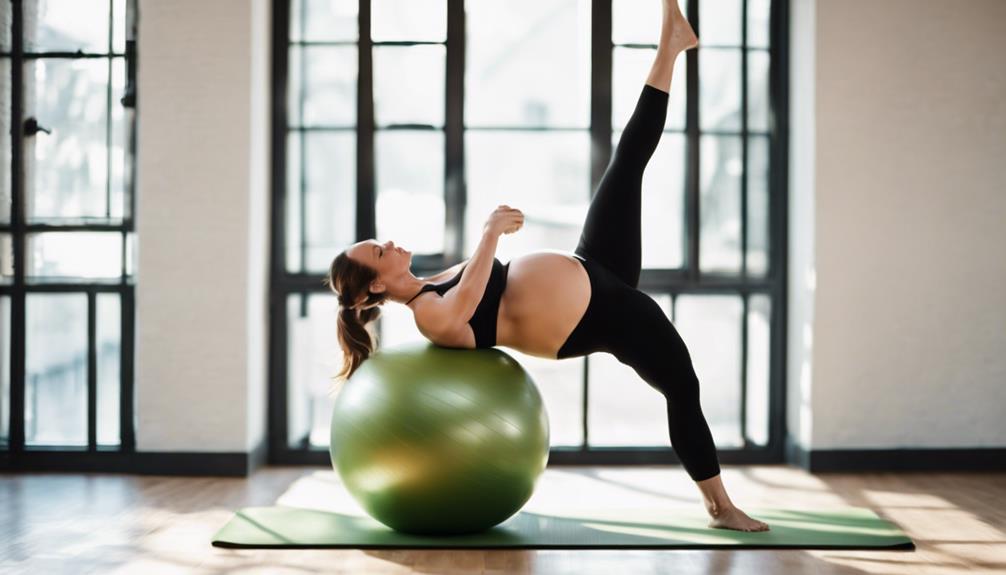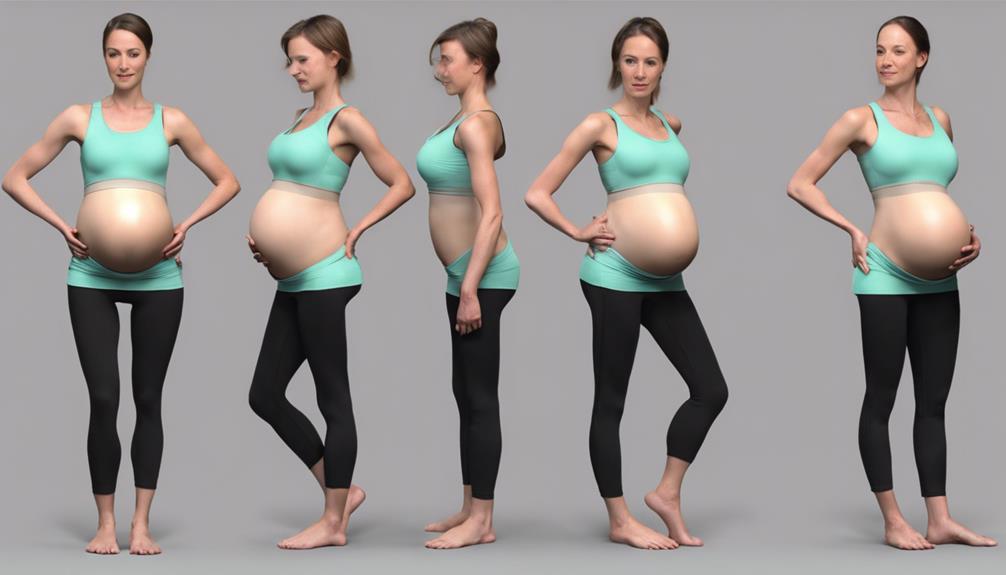Are you interested in staying active and maintaining a healthy lifestyle during your second trimester?
Wondering what safe workouts can benefit both you and your baby?
Discover seven effective exercises tailored for expectant mothers that promote physical well-being and prepare your body for childbirth.
From gentle prenatal yoga to low-impact cardio, these activities offer a range of benefits that go beyond just physical fitness.
So, are you ready to explore how these workouts can support you during this important stage of pregnancy?
Key Takeaways
- Low-impact cardio like walking and swimming boosts energy and circulation.
- Prenatal yoga enhances flexibility, reduces stress, and alleviates discomfort.
- Pelvic floor exercises improve core stability and reduce incontinence risk.
- Modified strength training with lighter weights maintains form and posture safely.
Low-Impact Cardio and Aerobics
Engage in low-impact cardio and aerobics during the second trimester to maintain cardiovascular health and support your well-being without risking guarantee or discomfort. Pregnancy is a beautiful journey, and these exercises like walking, swimming, or stationary biking can be your trusted companions for a healthy pregnancy. As your body goes through significant changes, these low-impact workouts offer a gentle way to stay active and energized.
In the second trimester, when your body is adapting to the growing baby, these cardio routines can work wonders. They boost your energy levels, enhance circulation, and contribute to an overall sense of well-being. Choosing low-impact exercises is a smart way to guarantee you're taking care of your body without overexerting yourself. By opting for activities that are gentle on your joints and muscles, you can reduce the risk of injury and discomfort, setting the stage for a smoother pregnancy journey.
Let's embrace these low-impact cardio sessions together for a healthier and happier pregnancy experience.
Prenatal Yoga and Stretching

Prenatal yoga and stretching are excellent choices for expecting mothers looking to stay active and healthy during the second trimester. These practices can help improve flexibility, ease discomfort, and promote relaxation through mindful breathing techniques.
Learning safe stretching techniques and being aware of poses to avoid can make prenatal yoga sessions both beneficial and enjoyable.
Benefits of Prenatal Yoga
During pregnancy, maintaining flexibility and strength is important for adapting to bodily changes, and prenatal yoga offers a gentle yet effective way to achieve this. Prenatal yoga provides a myriad of benefits:
- Improving Flexibility and Strength:
Prenatal yoga helps pregnant women enhance their flexibility and build strength, assisting in better coping with the physical demands of pregnancy.
- Promoting Relaxation and Stress Reduction:
Through breathing techniques and gentle movements, prenatal yoga fosters relaxation, reducing stress levels and promoting a sense of calm during this transformative time.
- Alleviating Pregnancy Discomforts:
Prenatal yoga can help ease common discomforts like back pain and swelling, making the journey to motherhood more comfortable and enjoyable for expecting mothers.
Safe Stretching Techniques
Improving flexibility and reducing muscle tension are key aspects of safe stretching techniques during pregnancy, particularly in the second trimester. Stretching exercises play an essential role in alleviating back pain and discomfort commonly experienced during this stage.
By engaging in proper stretching routines, you can enhance circulation, promote relaxation, and support your physical well-being throughout pregnancy. Focus on gentle movements that cater to the changing needs of your body, ensuring that each stretch is performed with mindfulness and care.
Incorporating stretching into your second trimester workouts not only aids in maintaining flexibility but also contributes to a sense of overall wellness. Embrace these crucial stretching techniques to nurture your body and prepare it for the beautiful journey ahead.
Yoga Poses to Avoid
To make sure a safe and beneficial prenatal yoga and stretching practice, it's important to be mindful of certain yoga poses that should be avoided during pregnancy.
- Avoid Deep Backbends: Poses like wheel or full camel can strain the back and may not be suitable during the second trimester.
- Steer Clear of Twisting Poses: Deep twists that involve the abdomen should be skipped to prevent unnecessary strain on the muscles.
- Say No to Jumping Movements: Poses requiring jumping or sudden movements should be avoided to prevent any potential abdominal trauma.
Swimming and Water Aerobics

Swimming and water aerobics offer pregnant individuals a gentle yet effective way to stay active and promote overall well-being during the second trimester. These low-impact exercises are particularly beneficial for expectant mothers experiencing back pain, as the buoyancy of water helps alleviate pressure on the joints and spine. Swimming, with its natural resistance, provides a full-body workout that supports muscle strength and cardiovascular health without straining the body. Water aerobics, on the other hand, can aid in improving circulation, reducing swelling, and enhancing flexibility.
Engaging in water-based activities not only helps to relieve physical discomfort but also contributes to mental relaxation and emotional well-being during pregnancy. Many women find the experience of swimming or participating in water aerobics to be invigorating, enjoyable, and rejuvenating. These exercises can be a soothing and safe way to maintain fitness levels and prepare the body for childbirth while minimizing the risk of injury.
Pelvic Floor Strengthening Exercises

Let's talk about the importance of pelvic floor exercises during the second trimester of pregnancy.
Strengthening these muscles is vital for core stability and can help reduce the risk of incontinence and prolapse.
Importance of Pelvic Floor
Strengthen your pelvic floor muscles to enhance core stability and reduce the risk of incontinence and prolapse during and after pregnancy. Here are three reasons why focusing on your pelvic floor is important:
- Core Stability: Pelvic floor muscles are essential for maintaining stability in your core, especially as your body changes during pregnancy.
- Incontinence Prevention: By strengthening these muscles, you can lower the risk of urinary incontinence that some women experience during and after pregnancy.
- Prolapse Support: Strong pelvic floor muscles help support your pelvic organs and can reduce the likelihood of prolapse, offering essential protection for your body.
Prioritizing pelvic floor exercises can contribute significantly to your postpartum recovery and overall pelvic health.
Effective Exercises to Try
As we move forward into discussing effective exercises to enhance pelvic floor strength, it's important to recognize the important impact these workouts can have on core stability and overall pelvic health, especially during and after pregnancy.
During the second trimester, engaging in pelvic floor exercises can greatly benefit pregnant individuals. These exercises not only support core stability but also play a vital role in improving bladder control and reducing the risk of incontinence and prolapse.
Strengthening the pelvic floor muscles is essential for postpartum recovery and can aid in a smoother labor and delivery process. By incorporating these exercises into your routine, you're actively investing in your pelvic health and overall well-being during this transformative time.
Benefits of Strengthening
Enhancing pelvic floor strength through targeted exercises is important for maintaining core stability and supporting overall pelvic health during pregnancy. These exercises offer numerous benefits for both you and your baby, such as reducing the risk of incontinence and pelvic organ prolapse, aiding in postpartum recovery, and improving pressure control throughout pregnancy.
By incorporating pelvic floor workouts into your routine, you're investing in long-term benefits that extend beyond pregnancy, ensuring a healthier pelvic floor and core stability. Prioritizing pelvic floor strengthening not only enhances your physical well-being during this important time but also sets the foundation for a strong and resilient body postpartum.
Let's embrace these exercises for a healthier pregnancy journey.
Modified Strength Training Workouts

During the second trimester of pregnancy, we emphasize incorporating modified strength training workouts that prioritize low-impact movements to safeguard against abdominal trauma. These workouts typically involve using lighter weights or resistance bands to reduce strain on the core muscles.
It's important to focus on maintaining proper form and posture throughout the exercises to lower the risk of injury. Core exercises are adjusted to avoid the supine position after the first trimester to prevent vena cava compression.
Remember to listen to your body, adjust the intensity as necessary, and consult with a prenatal fitness specialist for guidance tailored to your individual needs.
Walking and Brisk Walking

Moving on from modified strength training workouts, let's now explore the benefits and importance of incorporating walking and brisk walking into your second trimester pregnancy routine.
- Low-Impact Exercise: Walking is a safe and gentle way to stay active during the second trimester, providing numerous benefits for both you and your baby.
- Boosted Well-Being: Brisk walking can enhance cardiovascular health, uplift mood, and elevate energy levels, making it an excellent choice for pregnant women.
- Recommended Routine: Aim for at least 30 minutes of walking a day, three to five times per week. This consistent practice can help strengthen leg muscles, improve circulation, and support your overall physical well-being throughout your pregnancy journey.
During this vital period, it's essential to prioritize your comfort and safety. Invest in supportive footwear, listen to your body's cues, and enjoy the revitalizing effects of walking as you nurture yourself and your growing baby.
Let's step into this journey together with confidence and care.
Pilates for Pregnancy

Let's explore the benefits of incorporating Prenatal Pilates into your pregnancy routine during the second trimester. This specialized form of Pilates focuses on strengthening core muscles, including the pelvic floor, and promoting proper body alignment. By engaging in Prenatal Pilates, you can improve your posture, balance, and flexibility, which are particularly essential as your body undergoes significant changes during this stage of pregnancy. The controlled movements and breathing techniques involved in Prenatal Pilates not only enhance circulation but also aid in promoting relaxation, offering you some much-needed relief during this time.
One of the significant advantages of Prenatal Pilates is its ability to help reduce common discomforts such as back pain and pelvic pressure that many expecting mothers experience. The modified exercises in Prenatal Pilates are designed to be safe and effective for pregnant women, providing a low-impact workout option that can contribute positively to your overall well-being during the second trimester.
Frequently Asked Questions
What Exercise Is Good for 2nd Trimester Pregnancy?
Exercise is important in the second trimester of pregnancy for our well-being. We prioritize activities like prenatal yoga, swimming, and walking to boost mood and prepare for labor. It is necessary to consult experts, listen to our bodies, and stay hydrated.
Is It OK to Start Working Out in Second Trimester?
Absolutely, it's safe to start working out in the second trimester. We recommend consulting with your healthcare provider first. Exercise can enhance well-being, manage weight gain, and reduce discomfort. It's essential to prioritize safety and listen to your body.
What Are the Exercise Guidelines for the Second Trimester of Pregnancy?
We've got your back! In the second trimester, we recommend low-impact exercises like walking, swimming, and prenatal yoga. It's essential to stay safe and consult a prenatal trainer for guidance. Let's keep moving together!
Why Can't You Exercise on Your Back in Second Trimester?
We avoid exercising on our backs during the second trimester to prevent venous obstruction and dizziness caused by the uterus's weight pressing on major blood vessels. It's important for ensuring proper blood flow and oxygen supply for the baby.
Conclusion
As we wrap up our list of safe second trimester workouts for pregnancy, let's envision a serene scene: we're gently flowing through prenatal yoga poses by the water, feeling weightless and connected to our growing baby.
Embrace the strength and peace these workouts bring, knowing that you're nurturing both your body and your little one. Stay active, stay healthy, and enjoy this beautiful journey to motherhood.
You've got this!










